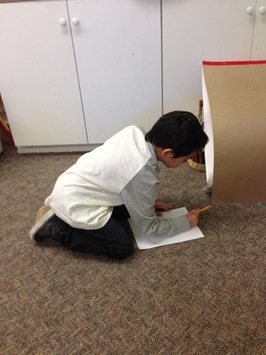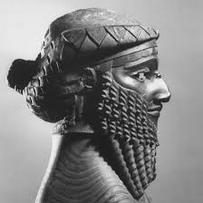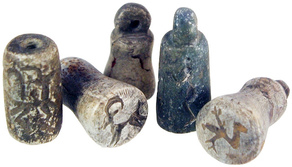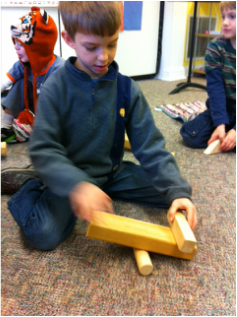|
11/25/13 with Kim Rodgers Writing GamesThis week Mrs. Besjak was on vacation, so I got a little taste of what life is like in the youngest class at Mosaic! We played some games from a book called, appropriately, Games for Writing. As students arrived there were blank papers separated into four sections waiting for them on the table. They were to draw four things they wanted me to know about them with words describing the pictures. If they had trouble writing they were to use the other kids at the table to help them. When they were finished they put them upside-down in a pile so I couldn’t see which one was theirs. When the class finished I grabbed the papers and we gathered in a circle on the floor. I shared each one with the class, trying to guess whose it was. We had a great time, as they laughed at me while I was trying to figure it out!  The next game we played was called A Race of Words. It was the class versus me. They had 10 minutes to walk around the room writing down or drawing a picture of everything they could see. They could do it in pairs or on their own, making sure they didn’t write about the same area as another student since they were getting points for each new item on their list. After 5 minutes I started my list. Since I had been a writer longer than them I got less time to write. When the time was up we gathered together to share our lists. I got one point for each item on my list. They got one point for each item they had on their list that I also had on my list. After sharing my list and adding up my points, they shared any items on their list that I didn’t have. They got three points for each of those items. Needless to say, I lost…badly!!! They did a great job staying focused and making their lists quite long. I didn’t have a chance!!  We finished up class by playing a game called Make a List. Together we created a list of ways we could thank a witch who agreed to teach us a magic spell. Sweep her cave. Buy her a cat. Pick herbs for her medicines. The students were then given a new task and asked to make a list. I had them imagine what it would be like if they took a rocket trip through the galaxy. They would be alone in space for an entire year. After the essential equipment was loaded on the ship, what extra items would they pack? The kids went to town writing down a flurry of ideas of things they would bring: iPads, pet dogs, spacedog suits, boxes of chocolate, and more! Some students needed help sounding out the words, but ALL the students had items they would bring along! I had a great time with the class and look forward to seeing them more often next semester! Simple Machines The ancient Egyptians used simple machines to build the pyramids and irrigate their fields. Today we learned about two simple machines:
12/2/13 The First Sumerian Dictator This week we read Story of the World Chapter 5 and learned about Sargon and the Akkadians. One story of Sargon tells how he floated down the Euhrates River in a basket as a baby and was found by a servant of the King of Kish. Sargon grew up inside the King's palace as one of his most trusted advisors and cup-bearers. Sargon grew to be a strong and ruthless leader, overthrowing the King and ultimately defeating all the city-states of Sumer to build an empire he called Akkadia. We used this opportunity to review some basic geography/map concepts including the four cardinal directions and how to draw a compass rose on a map. Students reviewed the geography of both Egypt and Mesopotamia that we had introduced earlier in the semester. They located the following areas on their maps:
We also discussed the meaning of a military dictatorship, and how Sargon was able to force people throughout the Akkadian cities to obey his laws through use of a punishing army. We contrasted this with our own democratic system and with the way rules are structured within our own homes and agreed that a dictatorship did not seem very fair... or fun!  We wrapped up class by creating our own Sumerian seals, made out of air dry clay. Many Sumerian people did not know how to read or write and could not sign their name, so instead created seals or stamps with a mark that was used like a signature. Next week we will see if our seals work when we roll them through play-doh! Continuing our Design of Simple Machines Last week we learned that the Ancient Egyptians used simple machines to help them in the work of daily living, such as the shaduf for irrigation, as well as the monumental task of building the pyramids. We also learned about levers. The lever was used in the shaduf and may have also been used to lift the heavy stones of the pyramids. As we discussed, there are many levers in use today in the world around us. There are three different types of levers, identified by the position of the effort, fulcrum, and load. Ask your child to make a lever at home, and identify the parts for you. Can they name one that we use today? Each week students choose to continue their work with materials that we have introduced in previous weeks, according to their own interests and abilities. We continue to enjoy the Ancient Egyptian number system as well, building numbers and then translating them to the numbers that we use today. We are also learning to tell time, make papyrus, and play mancala, find ways to make 10, add up to 100, and add in the tens of thousands.
Next we week will introduce measurement, and find out how the Ancient Egyptians measured distance. Have a great week! Comments are closed.
|
Categories
All
Archives
May 2016
|





 RSS Feed
RSS Feed